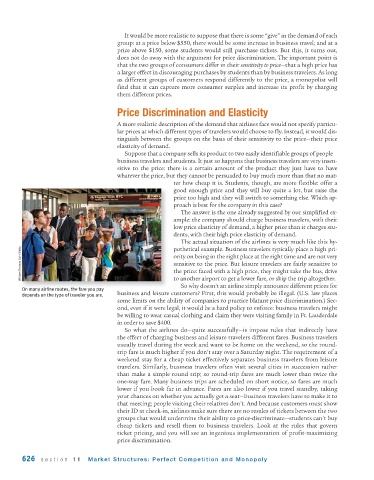Page 668 - Krugmans Economics for AP Text Book_Neat
P. 668
It would be more realistic to suppose that there is some “give” in the demand of each
group: at a price below $550, there would be some increase in business travel; and at a
price above $150, some students would still purchase tickets. But this, it turns out,
does not do away with the argument for price discrimination. The important point is
that the two groups of consumers differ in their sensitivity to price—that a high price has
a larger effect in discouraging purchases by students than by business travelers. As long
as different groups of customers respond differently to the price, a monopolist will
find that it can capture more consumer surplus and increase its profit by charging
them different prices.
Price Discrimination and Elasticity
A more realistic description of the demand that airlines face would not specify particu-
lar prices at which different types of travelers would choose to fly. Instead, it would dis-
tinguish between the groups on the basis of their sensitivity to the price—their price
elasticity of demand.
Suppose that a company sells its product to two easily identifiable groups of people—
business travelers and students. It just so happens that business travelers are very insen-
sitive to the price: there is a certain amount of the product they just have to have
whatever the price, but they cannot be persuaded to buy much more than that no mat-
ter how cheap it is. Students, though, are more flexible: offer a
good enough price and they will buy quite a lot, but raise the
price too high and they will switch to something else. Which ap-
proach is best for the company in this case?
The answer is the one already suggested by our simplified ex-
ample: the company should charge business travelers, with their
low price elasticity of demand, a higher price than it charges stu-
dents, with their high price elasticity of demand.
The actual situation of the airlines is very much like this hy-
pothetical example. Business travelers typically place a high pri-
William Thomas Cain/Getty ority on being in the right place at the right time and are not very
sensitive to the price. But leisure travelers are fairly sensitive to
the price: faced with a high price, they might take the bus, drive
to another airport to get a lower fare, or skip the trip altogether.
So why doesn’t an airline simply announce different prices for
On many airline routes, the fare you pay
depends on the type of traveler you are. business and leisure customers? First, this would probably be illegal. (U.S. law places
some limits on the ability of companies to practice blatant price discrimination.) Sec-
ond, even if it were legal, it would be a hard policy to enforce: business travelers might
be willing to wear casual clothing and claim they were visiting family in Ft. Lauderdale
in order to save $400.
So what the airlines do—quite successfully—is impose rules that indirectly have
the effect of charging business and leisure travelers different fares. Business travelers
usually travel during the week and want to be home on the weekend, so the round -
trip fare is much higher if you don’t stay over a Saturday night. The requirement of a
weekend stay for a cheap ticket effectively separates business travelers from leisure
travelers. Similarly, business travelers often visit several cities in succession rather
than make a simple round trip; so round-trip fares are much lower than twice the
one-way fare. Many business trips are scheduled on short notice, so fares are much
lower if you book far in advance. Fares are also lower if you travel standby, taking
your chances on whether you actually get a seat—business travelers have to make it to
that meeting; people visiting their relatives don’t. And because customers must show
their ID at check-in, airlines make sure there are no resales of tickets between the two
groups that would undermine their ability to price-discriminate—students can’t buy
cheap tickets and resell them to business travelers. Look at the rules that govern
ticket pricing, and you will see an ingenious implementation of profit - maximizing
price discrimination.
626 section 11 Market Structures: Perfect Competition and Monopoly

